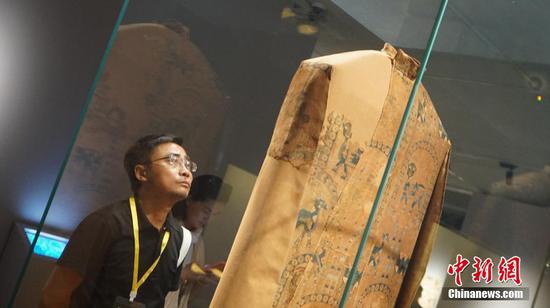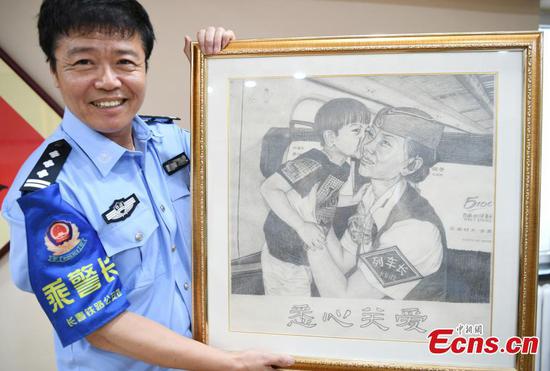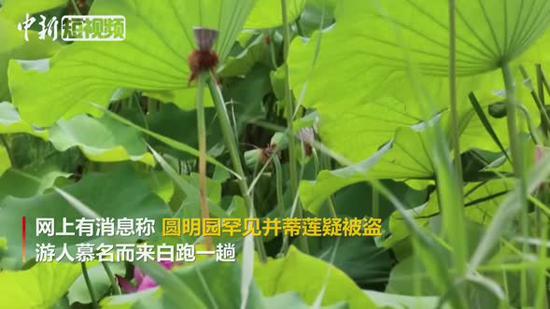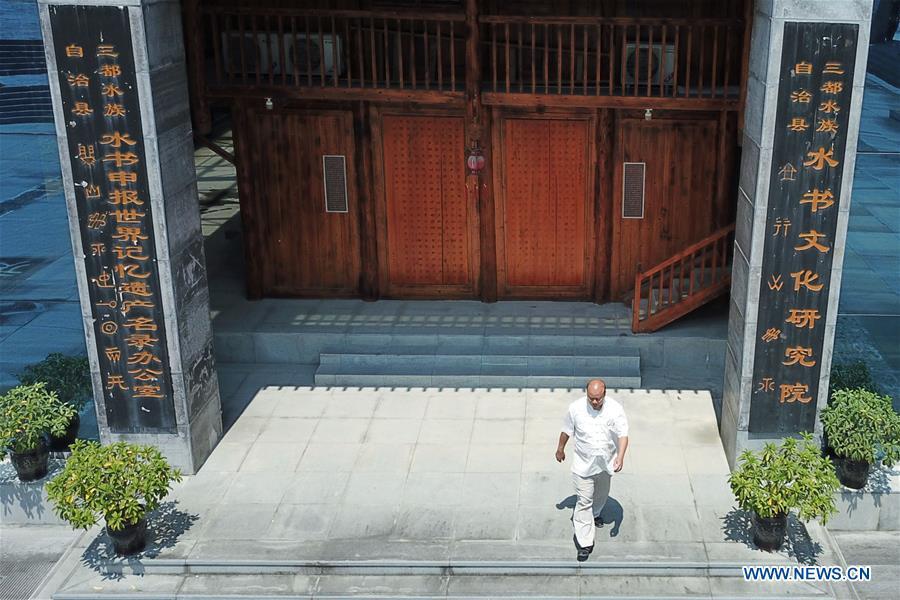
In this aerial photo taken on July 3, 2019, cultural researcher Wei Shizhao walks out of a local Shui script cultural institute in Sandu County, southwest China's Guizhou Province. Wei started learning Shui script in his childhood. So far, his modern Chinese translations of texts in Shui script have amounted to nearly three million characters. The Shui script is the unique pictographic writing system used by the Shui people in southwest China to keep records of their culture. Like the bronze and oracle bone inscriptions of ancient China, the Shui script consists of logograms invented a long time ago and is one of the few pictographic writing systems still in use. In 2006, it was listed as a national intangible cultural heritage. In Sandu County, preservation and research of the Shui script began in the 1980s. Researchers at a local Shui script cultural institute have been engaged in the collection and digitalization of relevant texts. Authorities are also working to register the Shui script in the UNESCO Memory of the World list. (Xinhua/Ou Dongqu)
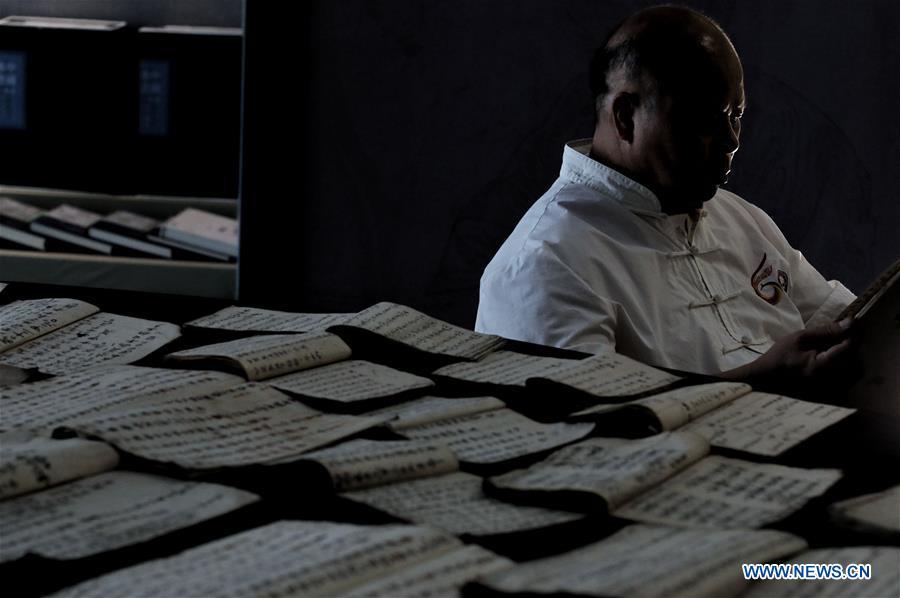
Cultural researcher Wei Shizhao reads a text in Shui script in Sandu County, southwest China's Guizhou Province, July 3, 2019. Wei started learning Shui script in his childhood. So far, his modern Chinese translations of texts in Shui script have amounted to nearly three million characters. The Shui script is the unique pictographic writing system used by the Shui people in southwest China to keep records of their culture. Like the bronze and oracle bone inscriptions of ancient China, the Shui script consists of logograms invented a long time ago and is one of the few pictographic writing systems still in use. In 2006, it was listed as a national intangible cultural heritage. In Sandu County, preservation and research of the Shui script began in the 1980s. Researchers at a local Shui script cultural institute have been engaged in the collection and digitalization of relevant texts. Authorities are also working to register the Shui script in the UNESCO Memory of the World list. (Xinhua/Ou Dongqu)
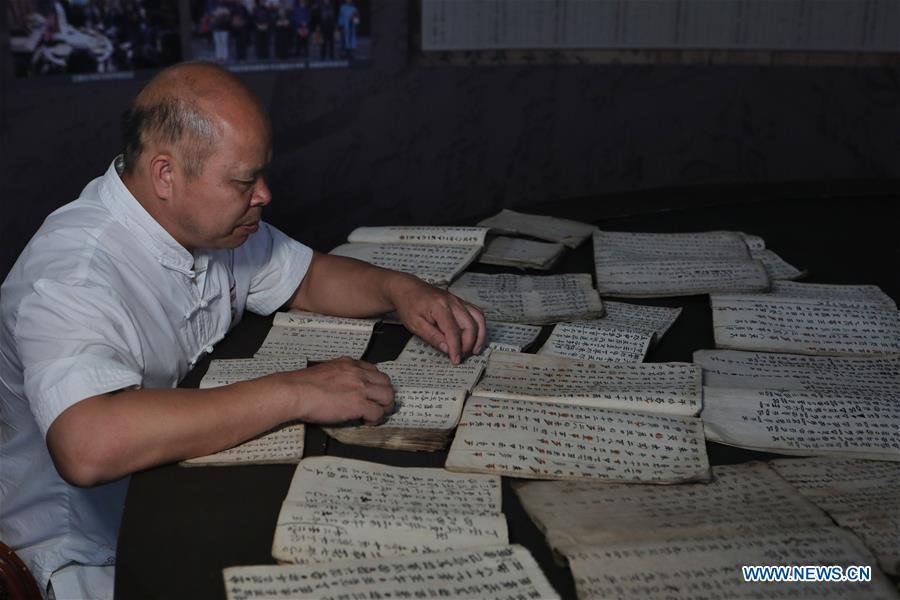
Cultural researcher Wei Shizhao organizes a collection of texts in Shui script in Sandu County, southwest China's Guizhou Province, July 3, 2019. Wei started learning Shui script in his childhood. So far, his modern Chinese translations of texts in Shui script have amounted to nearly three million characters. The Shui script is the unique pictographic writing system used by the Shui people in southwest China to keep records of their culture. Like the bronze and oracle bone inscriptions of ancient China, the Shui script consists of logograms invented a long time ago and is one of the few pictographic writing systems still in use. In 2006, it was listed as a national intangible cultural heritage. In Sandu County, preservation and research of the Shui script began in the 1980s. Researchers at a local Shui script cultural institute have been engaged in the collection and digitalization of relevant texts. Authorities are also working to register the Shui script in the UNESCO Memory of the World list. (Xinhua/Ou Dongqu)
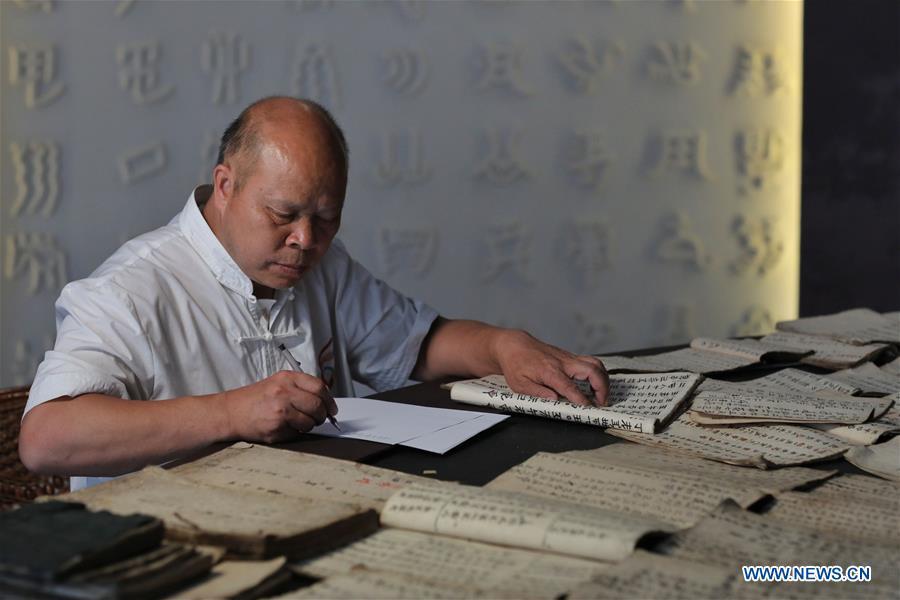
Cultural researcher Wei Shizhao makes handwritten copies of a text in Shui script in Sandu County, southwest China's Guizhou Province, July 3, 2019. Wei started learning Shui script in his childhood. So far, his modern Chinese translations of texts in Shui script have amounted to nearly three million characters. The Shui script is the unique pictographic writing system used by the Shui people in southwest China to keep records of their culture. Like the bronze and oracle bone inscriptions of ancient China, the Shui script consists of logograms invented a long time ago and is one of the few pictographic writing systems still in use. In 2006, it was listed as a national intangible cultural heritage. In Sandu County, preservation and research of the Shui script began in the 1980s. Researchers at a local Shui script cultural institute have been engaged in the collection and digitalization of relevant texts. Authorities are also working to register the Shui script in the UNESCO Memory of the World list. (Xinhua/Ou Dongqu)

In this aerial photo taken on July 3, 2019, cultural researcher Wei Shizhao walks out of a local Shui script cultural institute in Sandu County, southwest China's Guizhou Province. Wei started learning Shui script in his childhood. So far, his modern Chinese translations of texts in Shui script have amounted to nearly three million characters. The Shui script is the unique pictographic writing system used by the Shui people in southwest China to keep records of their culture. Like the bronze and oracle bone inscriptions of ancient China, the Shui script consists of logograms invented a long time ago and is one of the few pictographic writing systems still in use. In 2006, it was listed as a national intangible cultural heritage. In Sandu County, preservation and research of the Shui script began in the 1980s. Researchers at a local Shui script cultural institute have been engaged in the collection and digitalization of relevant texts. Authorities are also working to register the Shui script in the UNESCO Memory of the World list. (Xinhua/Ou Dongqu)
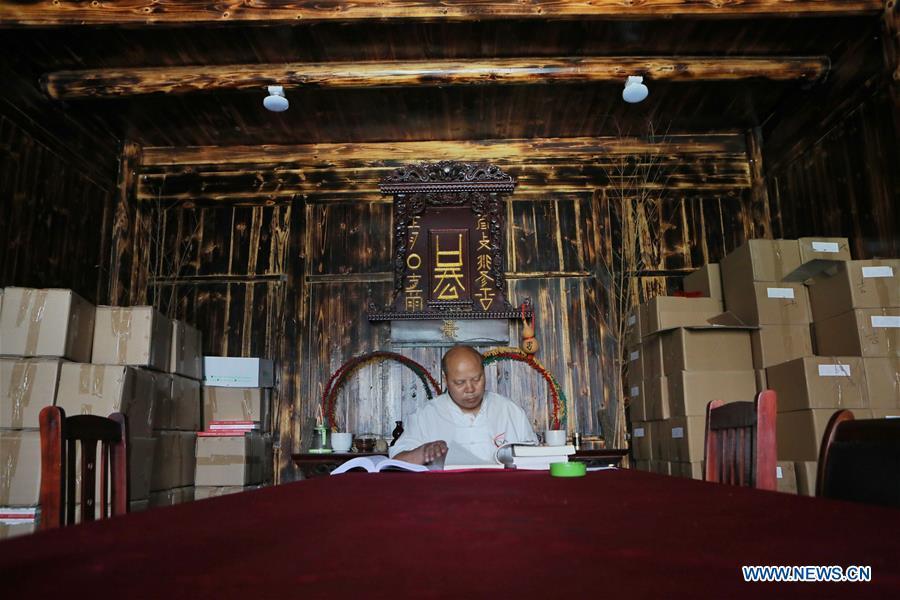
Cultural researcher Wei Shizhao proofreads one of his modern Chinese translations of Shui script in Sandu County, southwest China's Guizhou Province, July 3, 2019. Wei started learning Shui script in his childhood. So far, his modern Chinese translations of texts in Shui script have amounted to nearly three million characters. The Shui script is the unique pictographic writing system used by the Shui people in southwest China to keep records of their culture. Like the bronze and oracle bone inscriptions of ancient China, the Shui script consists of logograms invented a long time ago and is one of the few pictographic writing systems still in use. In 2006, it was listed as a national intangible cultural heritage. In Sandu County, preservation and research of the Shui script began in the 1980s. Researchers at a local Shui script cultural institute have been engaged in the collection and digitalization of relevant texts. Authorities are also working to register the Shui script in the UNESCO Memory of the World list. (Xinhua/Ou Dongqu)
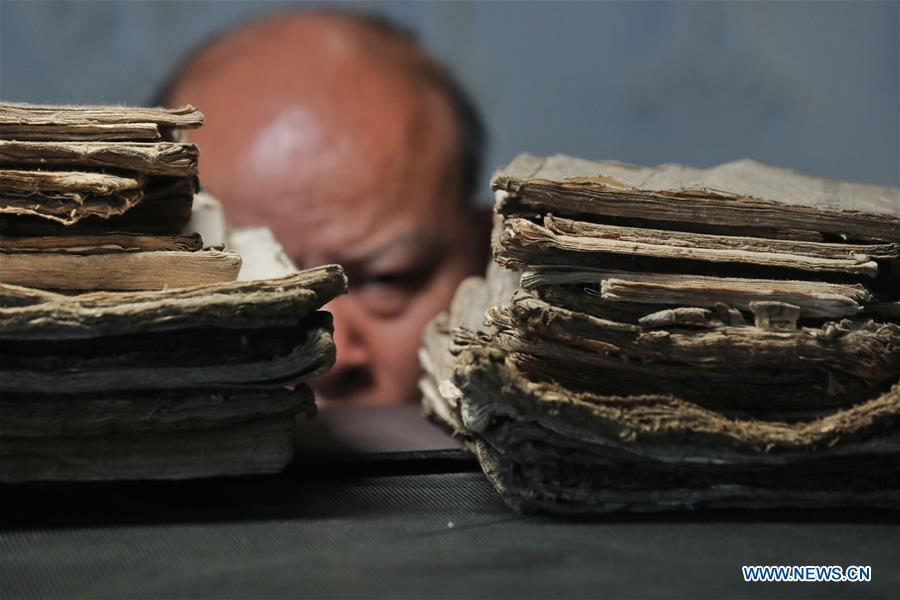
Cultural researcher Wei Shizhao examines a collection of texts in Shui script in Sandu County, southwest China's Guizhou Province, July 3, 2019. Wei started learning Shui script in his childhood. So far, his modern Chinese translations of texts in Shui script have amounted to nearly three million characters. The Shui script is the unique pictographic writing system used by the Shui people in southwest China to keep records of their culture. Like the bronze and oracle bone inscriptions of ancient China, the Shui script consists of logograms invented a long time ago and is one of the few pictographic writing systems still in use. In 2006, it was listed as a national intangible cultural heritage. In Sandu County, preservation and research of the Shui script began in the 1980s. Researchers at a local Shui script cultural institute have been engaged in the collection and digitalization of relevant texts. Authorities are also working to register the Shui script in the UNESCO Memory of the World list. (Xinhua/Ou Dongqu)
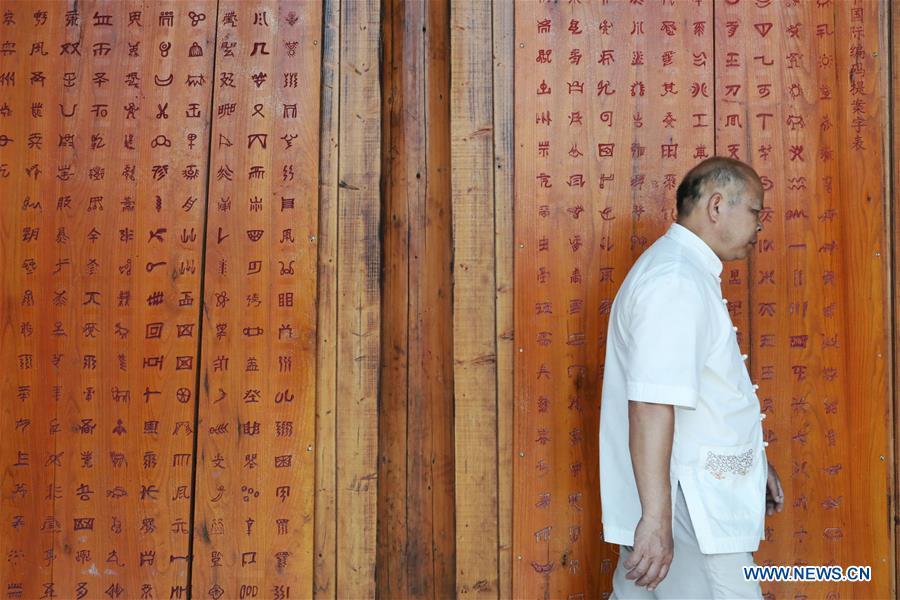
Cultural researcher Wei Shizhao walks past a plaque bearing Shui script characters at a local Shui script cultural institute in Sandu County, southwest China's Guizhou Province, July 3, 2019. Wei started learning Shui script in his childhood. So far, his modern Chinese translations of texts in Shui script have amounted to nearly three million characters. The Shui script is the unique pictographic writing system used by the Shui people in southwest China to keep records of their culture. Like the bronze and oracle bone inscriptions of ancient China, the Shui script consists of logograms invented a long time ago and is one of the few pictographic writing systems still in use. In 2006, it was listed as a national intangible cultural heritage. In Sandu County, preservation and research of the Shui script began in the 1980s. Researchers at a local Shui script cultural institute have been engaged in the collection and digitalization of relevant texts. Authorities are also working to register the Shui script in the UNESCO Memory of the World list. (Xinhua/Ou Dongqu)
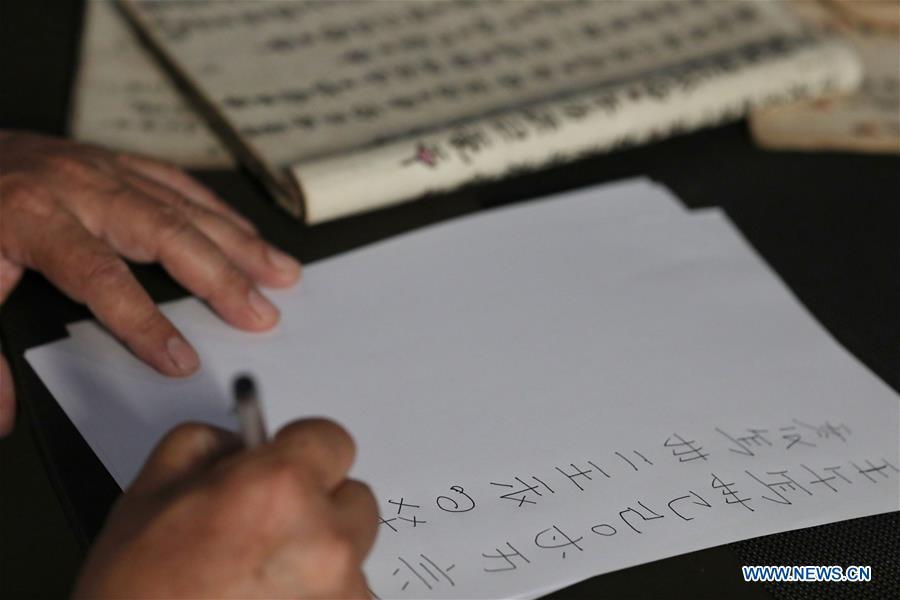
Cultural researcher Wei Shizhao makes handwritten copies of a text in Shui script in Sandu County, southwest China's Guizhou Province, July 3, 2019. Wei started learning Shui script in his childhood. So far, his modern Chinese translations of texts in Shui script have amounted to nearly three million characters. The Shui script is the unique pictographic writing system used by the Shui people in southwest China to keep records of their culture. Like the bronze and oracle bone inscriptions of ancient China, the Shui script consists of logograms invented a long time ago and is one of the few pictographic writing systems still in use. In 2006, it was listed as a national intangible cultural heritage. In Sandu County, preservation and research of the Shui script began in the 1980s. Researchers at a local Shui script cultural institute have been engaged in the collection and digitalization of relevant texts. Authorities are also working to register the Shui script in the UNESCO Memory of the World list. (Xinhua/Ou Dongqu)
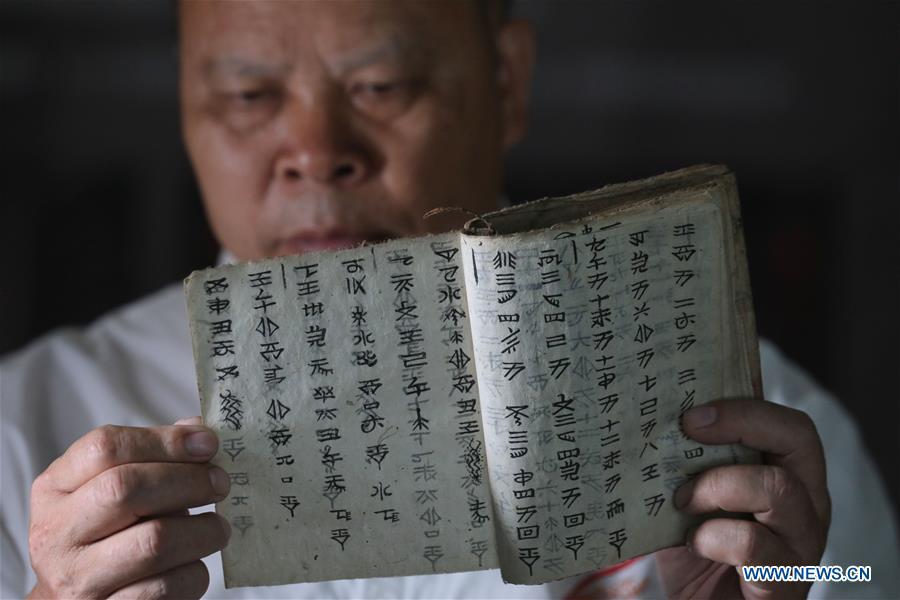
Cultural researcher Wei Shizhao reads a text in Shui script in Sandu County, southwest China's Guizhou Province, July 3, 2019. Wei started learning Shui script in his childhood. So far, his modern Chinese translations of texts in Shui script have amounted to nearly three million characters. The Shui script is the unique pictographic writing system used by the Shui people in southwest China to keep records of their culture. Like the bronze and oracle bone inscriptions of ancient China, the Shui script consists of logograms invented a long time ago and is one of the few pictographic writing systems still in use. In 2006, it was listed as a national intangible cultural heritage. In Sandu County, preservation and research of the Shui script began in the 1980s. Researchers at a local Shui script cultural institute have been engaged in the collection and digitalization of relevant texts. Authorities are also working to register the Shui script in the UNESCO Memory of the World list. (Xinhua/Ou Dongqu)
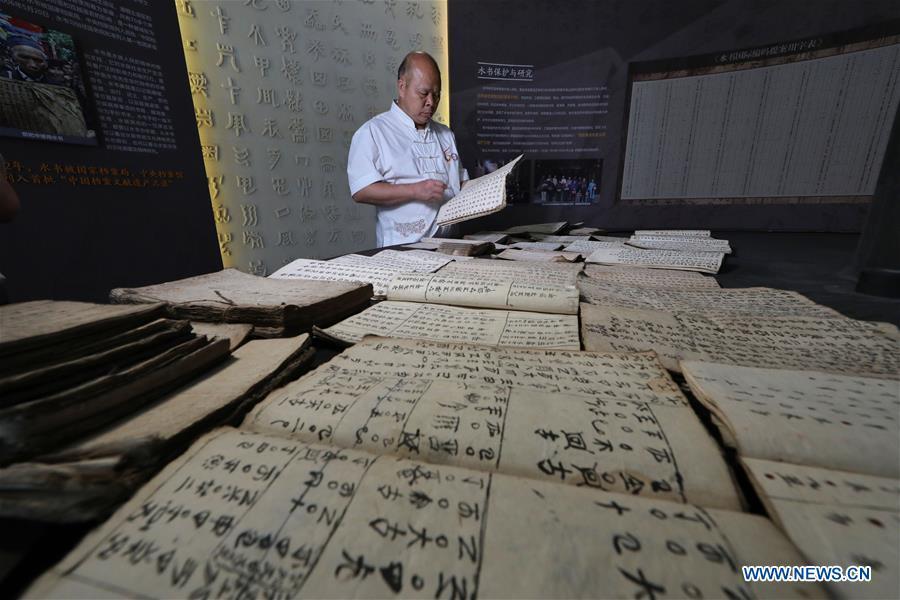
Cultural researcher Wei Shizhao organizes a collection of texts in Shui script in Sandu County, southwest China's Guizhou Province, July 3, 2019. Wei started learning Shui script in his childhood. So far, his modern Chinese translations of texts in Shui script have amounted to nearly three million characters. The Shui script is the unique pictographic writing system used by the Shui people in southwest China to keep records of their culture. Like the bronze and oracle bone inscriptions of ancient China, the Shui script consists of logograms invented a long time ago and is one of the few pictographic writing systems still in use. In 2006, it was listed as a national intangible cultural heritage. In Sandu County, preservation and research of the Shui script began in the 1980s. Researchers at a local Shui script cultural institute have been engaged in the collection and digitalization of relevant texts. Authorities are also working to register the Shui script in the UNESCO Memory of the World list. (Xinhua/Ou Dongqu)
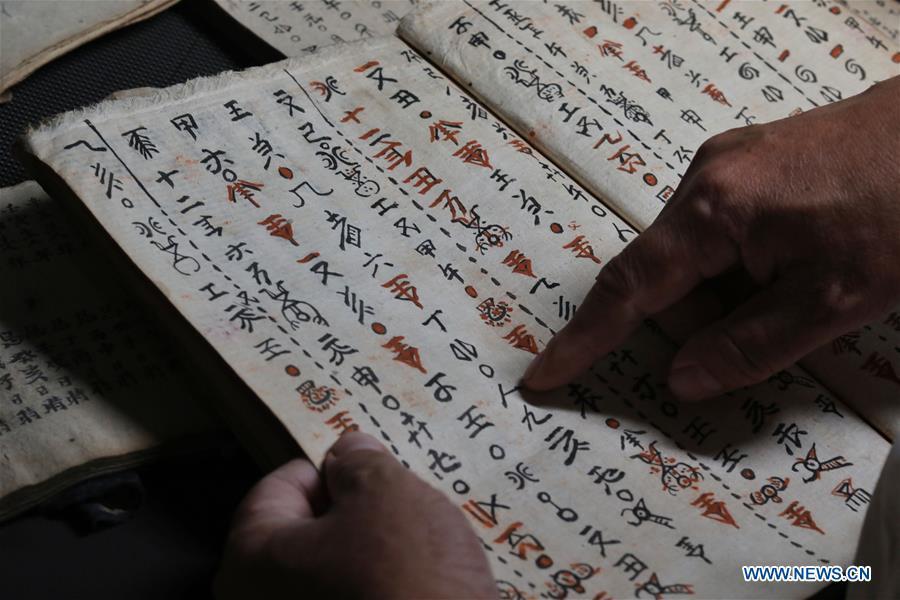
Cultural researcher Wei Shizhao organizes a collection of texts in Shui script in Sandu County, southwest China's Guizhou Province, July 3, 2019. Wei started learning Shui script in his childhood. So far, his modern Chinese translations of texts in Shui script have amounted to nearly three million characters. The Shui script is the unique pictographic writing system used by the Shui people in southwest China to keep records of their culture. Like the bronze and oracle bone inscriptions of ancient China, the Shui script consists of logograms invented a long time ago and is one of the few pictographic writing systems still in use. In 2006, it was listed as a national intangible cultural heritage. In Sandu County, preservation and research of the Shui script began in the 1980s. Researchers at a local Shui script cultural institute have been engaged in the collection and digitalization of relevant texts. Authorities are also working to register the Shui script in the UNESCO Memory of the World list. (Xinhua/Ou Dongqu)
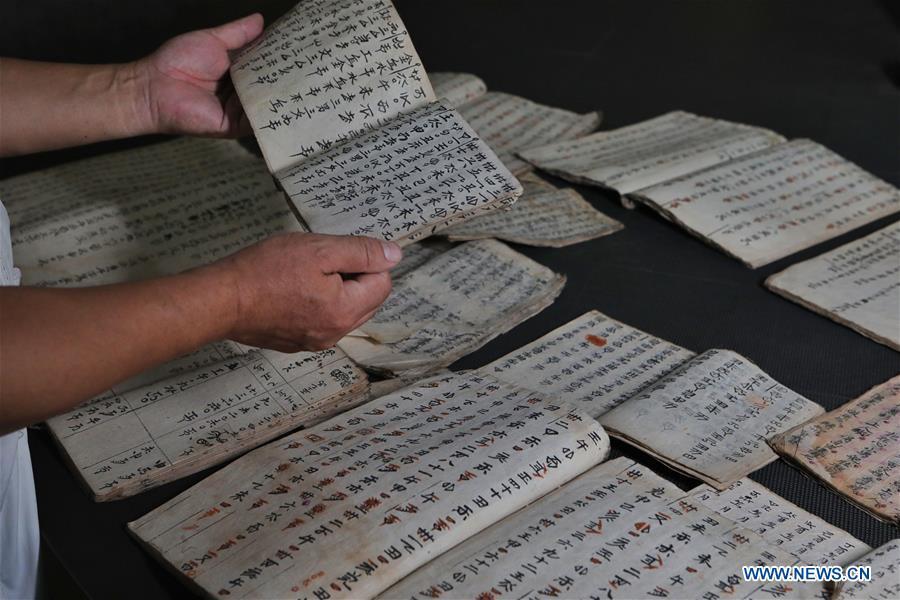
Cultural researcher Wei Shizhao organizes a collection of texts in Shui script in Sandu County, southwest China's Guizhou Province, July 3, 2019. Wei started learning Shui script in his childhood. So far, his modern Chinese translations of texts in Shui script have amounted to nearly three million characters. The Shui script is the unique pictographic writing system used by the Shui people in southwest China to keep records of their culture. Like the bronze and oracle bone inscriptions of ancient China, the Shui script consists of logograms invented a long time ago and is one of the few pictographic writing systems still in use. In 2006, it was listed as a national intangible cultural heritage. In Sandu County, preservation and research of the Shui script began in the 1980s. Researchers at a local Shui script cultural institute have been engaged in the collection and digitalization of relevant texts. Authorities are also working to register the Shui script in the UNESCO Memory of the World list. (Xinhua/Ou Dongqu)
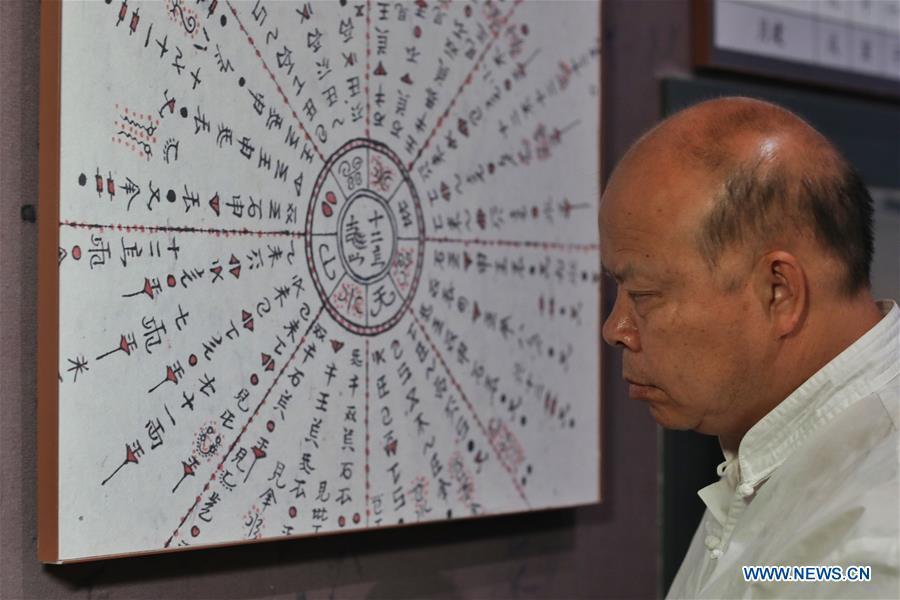
Cultural researcher Wei Shizhao looks at an exhibit in Shui script at a Shui ethnic culture museum in Sandu County, southwest China's Guizhou Province, July 3, 2019. Wei started learning Shui script in his childhood. So far, his modern Chinese translations of texts in Shui script have amounted to nearly three million characters. The Shui script is the unique pictographic writing system used by the Shui people in southwest China to keep records of their culture. Like the bronze and oracle bone inscriptions of ancient China, the Shui script consists of logograms invented a long time ago and is one of the few pictographic writing systems still in use. In 2006, it was listed as a national intangible cultural heritage. In Sandu County, preservation and research of the Shui script began in the 1980s. Researchers at a local Shui script cultural institute have been engaged in the collection and digitalization of relevant texts. Authorities are also working to register the Shui script in the UNESCO Memory of the World list. (Xinhua/Ou Dongqu)
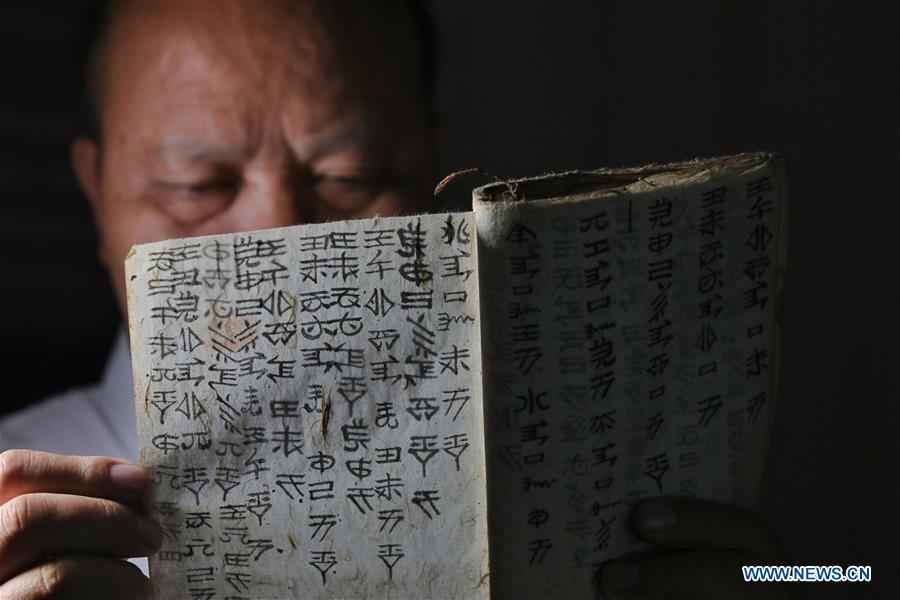
Cultural researcher Wei Shizhao reads a text in Shui script in Sandu County, southwest China's Guizhou Province, July 3, 2019. Wei started learning Shui script in his childhood. So far, his modern Chinese translations of texts in Shui script have amounted to nearly three million characters. The Shui script is the unique pictographic writing system used by the Shui people in southwest China to keep records of their culture. Like the bronze and oracle bone inscriptions of ancient China, the Shui script consists of logograms invented a long time ago and is one of the few pictographic writing systems still in use. In 2006, it was listed as a national intangible cultural heritage. In Sandu County, preservation and research of the Shui script began in the 1980s. Researchers at a local Shui script cultural institute have been engaged in the collection and digitalization of relevant texts. Authorities are also working to register the Shui script in the UNESCO Memory of the World list. (Xinhua/Ou Dongqu)



